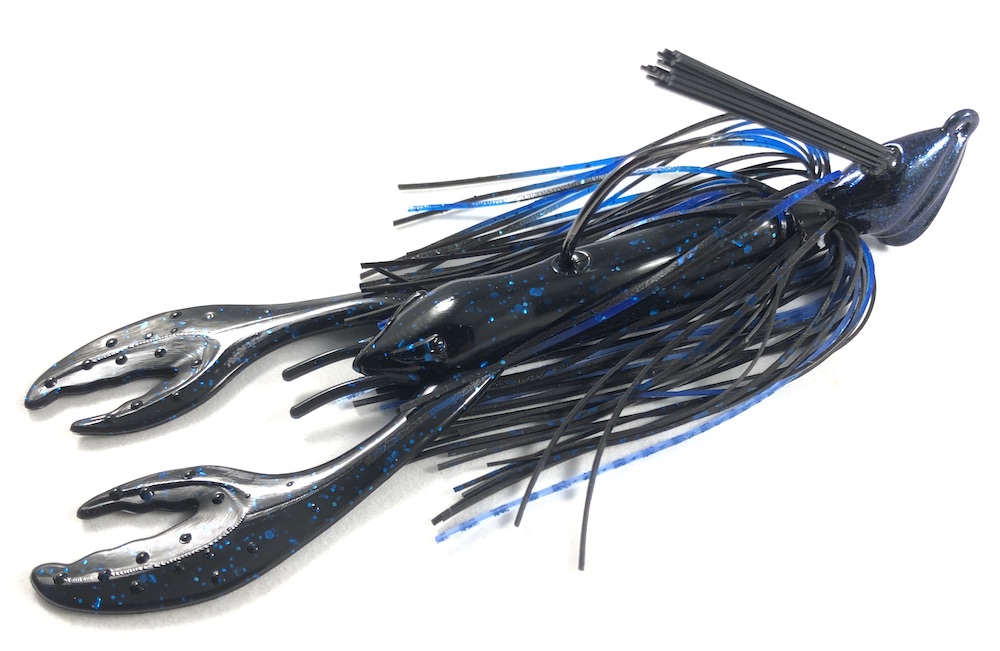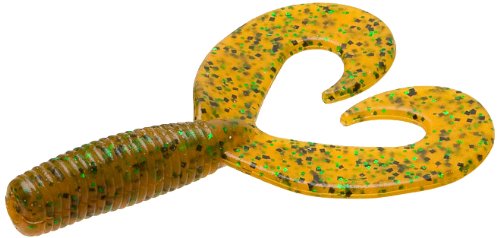
You will never see a bass fishermen fish a jig without a jig trailer. You may have heard older bass anglers refer to a “jig-n-pig” combo. This was slang for a jig with a pork rind trailer.
Nowadays anglers get the same general effect from a soft plastic version, but with many more shapes and colors to choose from. The purpose of a jig trailer is to give the jig more action and fill out the profile of the bait.
There are endless varieties of jig-and-trailer combinations. This gives anglers a ton of control over how the bait looks and performs. By simply switching out the trailer on a jig, you can instantly change the color scheme, the profile of the bait, and the type of action.
Being able to make changes to a bait on the fly like this without having to re-tie is another big advantage of jig fishing. When bass are being finicky it can be the slight tweak in color or action that gets bass to bite.
Top 5 Jig Trailers
There are many ways to fish a jig. So it makes sense that you would use certain types of trailers for certain styles of fishing. There are many factors to consider when picking the best jig trailer. Things like water clarity, type of vegetation, water depth, cloud cover, etc all play a role.
So let’s break down the different types of jig trailers, and when and why to use them.
1. Craw Trailers
The jig trailers that most anglers are probably familiar with are craw trailers. These trailers resemble a crayfish, or crawfish. Jigs are so often fished along the bottom that they are in most cases used to imitate a crawfish. This is why craw trailers are so popular.
The claws on these baits will usually have some movement to them as the bait moves through the water. The amount of action will vary from craw to craw. Some will have a very erratic flapping action while others will be more subtle, and some fall in between.
The amount of action and durability are the two factors to consider when selecting a craw. You don’t want the claws ripping off with every bite or hang up.
And while some anglers think the more action the better, it’s important to consider that crayfish don’t actually move their claws erratically when they swim.
If you’re looking for a great craw trailer with a more subtle action, check out the Battle Craw made by BiCO Performance Jigs. You also won’t find a more durable trailer.
2. Swim Jig Trailers
On a swim jig, you are more likely to see a paddle tail trailer used than anything else. These trailers are designed to imitate a swimming baitfish, with the end of the bait kicking side to side like a tail fin. A swim jig with a paddle tail trailer is ideal for trying to target bass that are feeding on a particular type of baitfish.
The biggest difference between one paddle tail trailer and the next is the kicking action of the tail itself. Some have a tight wobble, some have a wide wobble, and some have an erratic action.
Tighter wobbles with less action tend to work well in cold and/or clear water, while swim jig trailers with more action tend to work better in stained and/or warm water.
The Swim’n Caffeine Shad trailer made by Strike King in the photo above is one of the best swim jig trailers going.
3. Creature Baits
A creature bait is called a creature bait because it doesn’t represent any actual living thing. They kind of just look like big alien-looking bugs. There are many different styles with various types of appendages like claws and tentacles.
These trailers typically don’t give off much action. They’re more designed just to add to the profile of the bait by giving them bulk. General rule of thumb is the colder the water the less action you want from your trailer.
While that is a true general statement, there are going to be times, even in warm water, when bass are just reacting better to the dead action of a creature bait.
This is when a “beaver style” creature trailer like the Havoc Pit Boss made by PowerBait in the photo above would be a productive choice
4. Grub Trailers
A grub trailer is simply a grub, just used as a trailer. A grub is basically a shorter version of ribbon tail worm. But twin-tail grubs are the more popular choice. Which is the same idea but it has two ribbon tails extending off the body.
The tail (or tails) on the grub trailer makes a flapping action and creates a nice disturbance in the water. You decide how many tails by the level of action you want on your jig.
The Fat Albert twin tail grub made by Zoom in the photo above is a great choice. Zoom also makes good single tail grubs.
5. Chunk Trailers
Chunk trailers are small in size, usually no more than three inches in length. They resemble the old pork rinds that bass fishermen used decades ago. You can thread them on the hook the way you would any other trailer. Or the more traditional rig is to simply hook them through the middle of the body.
Chunk trailers work quite the opposite of the trailers mentioned previously. They have no action at all and add very little to the profile. Because of the small profile and dead action, these are the best jig trailers for fishing in cold water.
This is when bass, along with their prey, tend to slow down. So a craw or bait fish moving rapidly through the water is going to appear unnatural to a hunting bass.
The Super Chunk made by Zoom in the photo above is a great chunk trailer.










